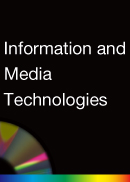Volume 9, Issue 2
Displaying 1-5 of 5 articles from this issue
- |<
- <
- 1
- >
- >|
Computing
-
2014Volume 9Issue 2 Pages 155-161
Published: 2014
Released on J-STAGE: June 15, 2014
Download PDF (811K)
Media (processing) and Interaction
-
2014Volume 9Issue 2 Pages 162-172
Published: 2014
Released on J-STAGE: June 15, 2014
Download PDF (2396K) -
2014Volume 9Issue 2 Pages 173-186
Published: 2014
Released on J-STAGE: June 15, 2014
Download PDF (233K) -
Tree-structured Mesoscopic Surface Characterization for Kinematic Structure Estimation from 3D Video2014Volume 9Issue 2 Pages 187-199
Published: 2014
Released on J-STAGE: June 15, 2014
Download PDF (10278K)
Computer Networks and Broadcasting
-
2014Volume 9Issue 2 Pages 200-208
Published: 2014
Released on J-STAGE: June 15, 2014
Download PDF (928K)
- |<
- <
- 1
- >
- >|
